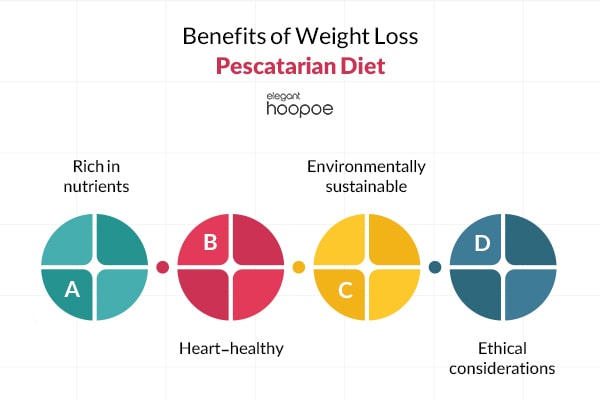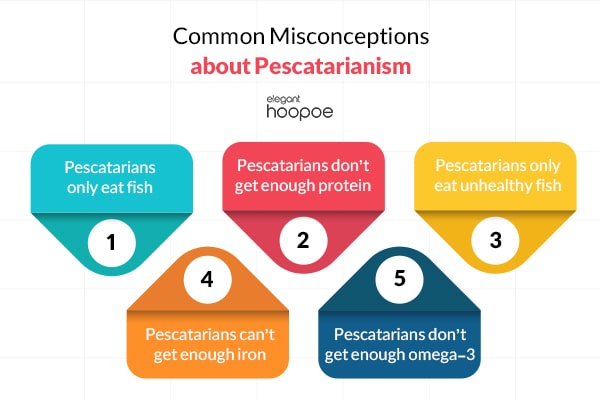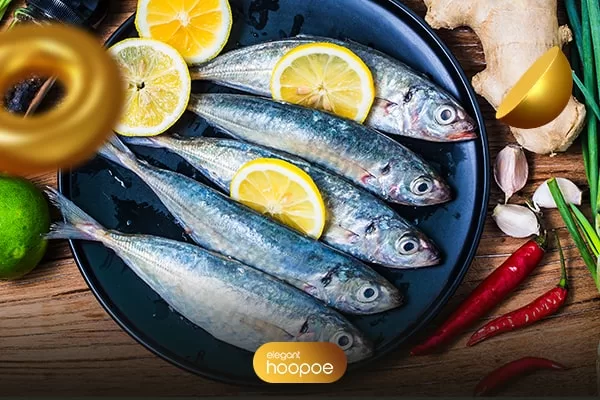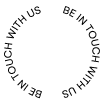What is a pescatarian diet? A pescatarian diet is one of the best diets for weight loss and a type of vegetarian diet that includes fish and seafood and other plant-based foods like fruits, vegetables, legumes, and whole grains. In the diet, a person is not allowed to eat meat but can eat fish. In other words, the diet in which only fish and other seafood are allowed, but red meat and chicken are still prohibited. Meaning that Pescatarians avoid eating meat, poultry, and sometimes dairy products (this is optional), but they incorporate fish and other seafood into their diet for protein and other essential nutrients.
Some people choose to follow the diet for health reasons, such as reducing their risk of heart disease, while others may choose it for ethical or environmental reasons.
Pescatarianism is a flexible and varied diet that can provide a wide range of health benefits when balanced and well-planned. There are many reasons why people use fish and seafood instead of red meat and chicken, which will be explained in detail below.
In this article on Elegant Hoopoe, we have explained the basic tips for starting a Pescatarian Diet. At first, as with any diet, consult a healthcare professional before starting the Diet to ensure that it aligns with your individual health goals and needs.
Related services:
How Does the Pescatarian Diet Work?
As we said, the Pescatarian diet is a flexible and sustainable way of eating that can provide a wide range of health benefits when balanced and well-planned. The Diet works by emphasizing the consumption of plant-based foods, fish, and seafood while limiting or eliminating meat and poultry.
By doing so, the diet promotes the intake of nutrient-dense foods that are high in protein, healthy fats, fiber, and essential vitamins and minerals, while reducing the intake of saturated fat and cholesterol found in animal products.
Fish and seafood are rich in omega-3 fatty acids, which are beneficial for heart health and brain function. They are also a good source of high-quality protein, iron, zinc, and other nutrients.
As fish and seafood have a lower carbon footprint compared to meat and poultry, following a Pescatarian diet can also cause reducing environmental impact. Additionally, ethical reasons cause some people to follow the Diet, as It reduces the amount of animal products.
Related article: MIND Diet for Weight Loss + Free Sample Meal Plans
Foods Allowed on the Pescatarian Diet
Some foods that you can eat on the Pescatarian diet:
- Fish and seafood such as salmon, tuna, trout, shrimp, scallops, mussels, clams, oysters, and… (main protein sources).
- All types of fruits including apples, bananas, berries, oranges, and more.
- Vegetables such as leafy greens, broccoli, cauliflower, carrots, tomatoes, and peppers are some good options.
- Legumes such as lentils, beans, and chickpeas, are excellent sources of protein and fiber and can be used in soups, stews, and salads.
- Whole grains such as brown rice, quinoa, and whole-wheat bread (they are good sources of complex carbohydrates and fiber)
- Nuts and seeds such as almonds, walnuts, chia seeds, and flaxseeds (they are good sources of healthy fats and protein)
- Dairy products such as milk, yogurt, and cheese are optional.
Note: Choose fish and seafood that are low in mercury and other contaminants, and incorporate a variety of plant-based protein sources to ensure adequate protein intake.
Foods to Avoid on the Pescatarian Diet
Pescatarian food list that is typically you can’t eat on the Pescatarian diet:
- Beef, pork, chicken, and other types of meat and poultry
- Processed foods, such as fast food, frozen meals, and snack foods (they are typically high in unhealthy fats, salt, and added sugars)
- Certain types of fish, such as swordfish, shark, and king mackerel, are high in mercury and should be avoided or consumed in moderation.
- Fried foods, such as fried fish (have high unhealthy fats)
- Refined carbohydrates, such as white bread, white rice, and pasta (are low in nutrients and can spike blood sugar levels). Whole grains are a better option.
- Sugary beverages, such as soda and juice (high in added sugars)
Note: The diet is flexible and can be adapted to individual needs and preferences. Some people include certain animal products, such as eggs or dairy in their diet. In any way, choose a variety of nutrient-dense foods to ensure that nutrient needs are met.
Related article: Effect of Rice on Weight : Is Rice Good For Weight Loss?

Pros and Cons of a Pescatarian Diet
The diet can be a healthy and sustainable way of eating when well-planned and balanced. However, you should be mindful of potential nutrient deficiencies and choose fish and seafood sources carefully to avoid exposure to contaminants. Some pros and cons of following a Pescatarian diet include:
pescatarian diet benefits
- Rich in nutrients: A variety of nutrient-dense foods, such as fish, seafood, fruits, vegetables, legumes, and whole grains can provide a range of essential vitamins, minerals, and fiber.
- Heart-healthy: Fish and seafood are high in omega-3 fatty acids reducing the risk of heart disease.
- Environmentally sustainable: Choosing fish and seafood over meat and poultry can help reduce your carbon footprint and promote sustainable food choices.
- Ethical considerations: Pescatarians can avoid consuming meat while still including fish and seafood in their diet, which may align with their ethical and moral values.
Pescatarian diet drawbacks
- Mercury and other contaminants: Some types of fish and seafood may have high mercury or other contaminants. These ingredients can be harmful to health if consumed in large quantities.
- Limited protein sources: Without meat and poultry, Pescatarians may have limited protein sources. Then it is necessary to plan carefully to ensure adequate intake.
- Potential nutrient deficiencies: Vitamin B12 is primarily found in animal products, therefore Pescatarians may be at risk of nutrient deficiencies.
- Higher cost: Some types of fish and seafood can be more expensive than meat and poultry, then some people may consider it difficult to follow a Pescatarian diet because of a budget.
Related article: Sirtfood Diet for Weight Loss
Sample one-day meal plan for the Pescatarian Diet
Breakfast
- Oatmeal with fresh berries and a sprinkle of chopped nuts
- A side of scrambled eggs made with spinach and feta cheese
Morning Snack
- Sliced apple with almond butter
Lunch
- Grilled salmon with a side of mixed greens and roasted sweet potatoes
- A slice of whole-grain bread
Evening Snack
- Carrots and cucumber with hummus
Dinner
- Shrimp stir-fry with vegetables (such as bell peppers, broccoli, and snap peas) and brown rice
- A Side of Edamame
Bed-Time Dessert
- Greek yogurt with honey and sliced strawberries
Note: the Pescatarian diet can be adjusted to fit individual preferences and dietary needs.
Related article: Probiotics for Weight Loss
Sample one-week meal plan for the Pescatarian Diet Menu
Day 1
- Breakfast: Avocado toast with smoked salmon and a side of fresh berries
- Morning Snack: Sliced cucumbers and cherry tomatoes with hummus
- Lunch: Quinoa and black bean salad with diced bell peppers and a side of sliced oranges
- Evening Snack: Greek yogurt with honey and chopped nuts
- Dinner: Grilled tuna steak with roasted vegetables (such as zucchini, eggplant, and cherry tomatoes)
Day 2
- Breakfast: Spinach and feta omelet with a side of sliced cantaloupe
- Morning Snack: Apple slices with almond butter
- Lunch: Lentil soup with a side of mixed greens and sliced cucumber
- Evening Snack: Trail mix with almonds, walnuts, and dried cranberries
- Dinner: Shrimp and vegetable stir-fry with brown rice
Day 3
- Breakfast: Blueberry smoothie bowl topped with granola and sliced banana
- Morning Snack: Carrots and celery with tzatziki sauce
- Lunch: Grilled salmon salad with mixed greens, cherry tomatoes, and balsamic vinaigrette
- Evening Snack: Greek yogurt with sliced strawberries and honey
- Dinner: Vegetable lasagna with a side of garlic bread
Day 4
- Breakfast: Banana and almond butter overnight oats
- Morning Snack: Roasted chickpeas
- Lunch: Tuna salad with mixed greens and a side of sliced oranges
- Evening Snack: Trail mix with cashews, raisins, and dark chocolate chips
- Dinner: Grilled halibut with grilled vegetables (such as asparagus, bell peppers, and onions)
Day 5
- Breakfast: Smoked salmon and cream cheese on a whole-grain bagel with a side of fresh berries
- Morning Snack: Sliced apple with cheddar cheese
- Lunch: Chickpea and quinoa bowl with mixed greens, cherry tomatoes, and balsamic vinaigrette
- Evening Snack: Greek yogurt with honey and chopped nuts
- Dinner: Grilled shrimp with roasted sweet potatoes and green beans
Day 6
- Breakfast: Vegetable and egg scramble with a side of sliced cantaloupe
- Morning Snack: Roasted almonds
- Lunch: Tomato and mozzarella salad with mixed greens and balsamic vinaigrette
- Evening Snack: Sliced pear with almond butter
- Dinner: Grilled swordfish with roasted vegetables (such as Brussels sprouts, carrots, and onions)
Day 7
- Breakfast: Blueberry and banana smoothie with a side of sliced apple and cheddar cheese
- Morning Snack: Trail mix with peanuts, raisins, and dried cranberries
- Lunch: Shrimp and avocado salad with mixed greens and balsamic vinaigrette
- Evening Snack: Greek yogurt with sliced banana and honey
- Dinner: Grilled vegetable kebabs (such as zucchini, bell peppers, and mushrooms) with a side of brown rice
Note: This is just a sample meal plan and you can accommodate it according to individual preferences and dietary needs.
Related article: Plant-based diet for Weight Loss + Free Sample Meal Plans
Who should avoid the Pescatarian diet?
Some groups of people should approach this diet with caution or avoid it altogether.
- If you have a seafood allergy, obviously you should avoid all seafood, including fish, shellfish, and crustaceans. The diet would not be suitable for you.
- Pregnant or breastfeeding women should be cautious when following the diet because some types of fish contain high levels of mercury, which can harm fetal and infant development.
- People with certain medical conditions such as gout, high blood pressure, or kidney disease may need to limit their intake of seafood due to its high purine and sodium content.
- Vegans or vegetarians who avoid all animal products, including fish, would not follow the diet.
Note: It’s always a good idea to consult with a healthcare provider or dietitian to ensure that your diet is meeting your nutrient needs.
How to Get Enough Protein on a Pescatarian Diet?
Getting enough protein on a Pescatarian diet is generally not a concern as fish and seafood are excellent sources of protein. But varying your protein sources ensures you’re getting all the essential amino acids your body needs. If you’re concerned about getting enough protein on the diet, you can always consult with a registered dietitian who can help you plan balanced meals that meet your individual needs.
Fish and seafood, eggs, dairy products, legumes, nuts, and seeds are all good sources of high-protein foods. Note that the body absorbs protein better when it’s consumed in combination with carbohydrates. This means that pairing protein-rich foods with whole grains or starchy vegetables can help ensure that your body is getting the most out of the protein you consume.
Potential Nutrient Deficiencies
Some nutrients may be lacking in the diet if not planned properly. Some potential nutrient deficiencies that may occur on a Pescatarian diet include:
Vitamin B12 is found mainly in animal products, including meat, and dairy. When you don’t consume enough of these foods, you may be at risk for a deficiency.
Tip: To ensure adequate intake, you can consider taking a B12 supplement or consuming B12-fortified foods like cereals or plant milk.
While fish and seafood contain some iron, it’s not as easily absorbed by the body as iron from meat sources. When you don’t consume enough iron-rich plant foods like beans, lentils, and spinach, you may be at risk for iron deficiency.
Tip: To increase iron absorption, you can pair iron-rich plant foods with vitamin C-rich foods like citrus fruits or bell peppers.
Vitamin D is important for bone health and immune function. Although some fish like salmon and tuna contain vitamin D, it can be difficult to get enough from food alone.
Tip: To ensure adequate intake, you can consider taking a vitamin D supplement or consuming vitamin D-fortified foods like plant milk or orange juice. It is the best idea to get enough sun exposure to don’t be at risk for a vitamin D deficiency.
Note: To prevent nutrient deficiencies, pescatarians should focus on consuming a variety of nutrient-dense foods and consider taking supplements or fortified foods when necessary.
Related article: Garcinia Cambogia for Weight Loss
Tips for meal planning
Including a variety of fish and seafood in your meal plan, ensure that you’re getting enough protein and omega-3 fatty acids. You can also add other protein sources like eggs, dairy, and plant-based options like legumes, nuts, and seeds.
Fruits and vegetables are important sources of vitamins, minerals, and fiber. Incorporating a variety of fruits and vegetables in your meal plan, ensure that you’re getting a range of nutrients.
Whole grains like brown rice, quinoa, and whole-wheat bread are great sources of fiber and other nutrients. Swap refined grains for whole grains in your meal plan.
Fish and seafood can be grilled, baked, broiled, or sautéed. Different cooking methods keep things interesting and bring out different flavors and textures.
Sauces and marinades can add flavor to fish and seafood dishes and can help keep them from drying out during cooking. Try making your sauces and marinades using ingredients like herbs, spices, and citrus.
Meal prepping can help save time and make it easier to stick to your meal plan. Consider prepping ingredients like vegetables, grains, and proteins ahead of time to make mealtime easier.
Snacks can be a great way to keep your energy levels up throughout the day. Consider including healthy snacks like nuts, seeds, fruit, and veggies in your meal plan.
Related article: 80/20 Diet Plan, What Is Weekend Diet?
Pescatarian Diet and Weight Loss
A diet can be an effective way to lose weight, especially when combined with regular physical activity and healthy lifestyle habits. It emphasizes whole, nutrient-dense foods and limits processed and high-calorie foods. Pescatarian diet plan for weight loss and some ways in which the diet may support weight loss include:
- Lower calorie intake: The diet is naturally lower in calories than a standard Western diet that includes meat. Fish and seafood are typically lower in calories and fat than meat, and the diet emphasizes fruits, vegetables, and whole grains, which are generally lower in calories than processed and high-fat foods.
- Increased nutrient density: The diet emphasizes whole, nutrient-dense foods, which can help provide a range of important nutrients while keeping calorie intake in check. When the body is getting all the nutrients it needs, it may be easier to avoid overeating and maintain a healthy weight
- Higher protein intake: Fish and seafood are rich sources of protein, which can help support feelings of fullness and reduce overall calorie intake. Protein also requires more energy to digest than carbohydrates or fat, which means that the body burns more calories when digesting protein.
- Improved blood sugar control: The Pescatarian diet emphasizes complex carbohydrates like whole grains and vegetables, which are digested more slowly than refined carbohydrates like white bread and sugary foods. This can help prevent blood sugar spikes and crashes, which can lead to overeating and weight gain.

Common Misconceptions about Pescatarianism
- Pescatarians only eat fish
While fish and seafood are a major component of the Pescatarian diet, it also includes other protein sources such as eggs, dairy, and plant-based options like legumes, nuts, and seeds.
- Pescatarians don’t get enough protein
This is a common misconception, as fish and seafood are rich sources of protein. A serving of fish can provide as much protein as a serving of chicken or beef.
- Pescatarians only eat unhealthy fish
While some types of fish can be high in mercury and other toxins, many types of fish are low in toxins and high in nutrients. Pescatarians can choose from a variety of fish and seafood options to ensure that they’re getting a balanced and healthy diet.
- Pescatarians can’t get enough iron
While it’s true that plant-based sources of iron are less easily absorbed by the body than animal-based sources, many types of fish and seafood are also good sources of iron. Additionally, consuming foods high in vitamin C can help improve iron absorption.
- Pescatarians don’t get enough omega-3 fatty acids
This is a common misconception, as fish and seafood are rich sources of omega-3 fatty acids, which are important for heart and brain health. Pescatarians can also incorporate other sources of omega-3s like chia seeds, flaxseeds, and walnuts into their diet.
Comparing the Pescatarians Diet to Other Popular Diets
| Diet | Description | Protein Source | Macronutrient Ratio | Pros | Cons |
| Pescatarian | A diet that includes fish and seafood | Fish, seafood | Balanced | Rich in omega-3s, low in saturated fat, may reduce risk of chronic diseases | Limited sources of protein, potential for mercury and other contaminant exposure from seafood |
| Vegetarian | A diet that excludes meat and fish | Dairy, legumes | Balanced | May reduce risk of chronic diseases, environmentally sustainable | Limited sources of protein, potential for nutrient deficiencies |
| Vegan | A diet that excludes all animal products | Legumes, tofu | Low in fat, high in carbs and fiber | May reduce risk of chronic diseases, environmentally sustainable | Limited sources of protein, potential for nutrient deficiencies, may require careful planning to ensure adequate nutrient intake |
| Mediterranean | A diet based on traditional Mediterranean foods | Fish, poultry | Balanced | May reduce risk of chronic diseases, rich in healthy fats and fiber | Limited sources of protein, may be high in calories and fat |
| Paleo | A diet based on what humans ate during the Paleolithic era | Meat, poultry, fish | High in protein and fat, low in carbs | May lead to weight loss, may improve blood sugar control | Limited sources of carbs, potential for high intake of saturated fat and cholesterol |
| Keto | A high-fat, low-carb diet | Meat, fish, eggs | High protein, low-carbohydrate | May lead to weight loss, may improve blood sugar control | Limited sources of carbs, potential for nutrient deficiencies, may be difficult to sustain long-term |
Note: Each of these diets has different health benefits and potential drawbacks. Choosing the right diet depends on individual needs, goals, and preferences. Each diet may be more or less suitable for different individuals depending on their health status, lifestyle, and personal preferences. It’s always best to consult a healthcare professional before starting a new diet.
Concluding Remarks
The Pescatarian diet is a flexible and nutritious eating pattern that includes fish and seafood as the primary source of protein while limiting or eliminating meat and poultry. The diet is rich in nutrients like omega-3 fatty acids, vitamins, and minerals, and has been associated with various health benefits, including reduced risk of chronic diseases. Be aware of potential nutrient deficiencies and contaminants in seafood. Eating out on a Pescatarian diet can be a bit challenging, but there are several tips and strategies you can use to make it easier:
Seafood restaurants are a great option for Pescatarians as they offer a wide range of fish and seafood dishes. Check out the menu beforehand to see what options are available. Before heading to a restaurant, check their menu online to see what options are available for Pescatarians. Look for vegetarian or seafood dishes that can be modified to fit your dietary needs.
Don’t be afraid to ask for modifications to menu items to fit your dietary needs. For example, ask for a salad without meat and add extra vegetables or seafood instead. When in doubt, opt for simple dishes like grilled fish or seafood with a side of vegetables. These dishes are usually easy to modify and can be made to fit your dietary needs.
Pay attention to how dishes are prepared, as some cooking methods like deep-frying can add unnecessary calories and unhealthy fats. Opt for grilled, baked, or steamed dishes instead. If you’re not sure if there will be options available for you, consider bringing your food. Pack a healthy meal or snack to enjoy while others eat, or bring a Pescatarian-friendly dish to share.







